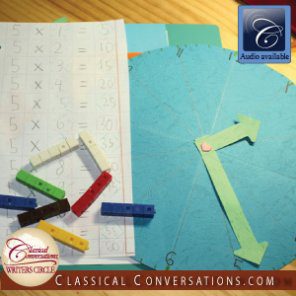This morning I visited my local Classical Conversations community and observed my son’s Challenge II class and my daughter’s Challenge B class. For both, I was able to be with them during the math seminar and witness some good math teaching. I will not name the tutors, so as not to embarrass anyone, but I will share what I was able to learn from them: namely, what makes a great math tutor.
First, the tutors asked lots of questions. They started out by asking, in general, if the students had any questions regarding their preparation of the lessons. Then, they asked the students specific questions about what kind of question they were solving, what concept they were considering, can the question be written different ways, and can it be simplified before they proceed to solving it? In doing so, the majority—if not all—of the students were actively participating in the math discussion, a real dialectic of math.
Second, the tutors never assumed there was only one way to solve the math question. If a particular method were used to solve it, the tutors would ask if anyone had solved it another way. In doing so, they were able to help the students recognize different ways of thinking through the concept; sometimes, this process helped them to discover why a particular step worked in the solution.
Third, the tutors never embarrassed anyone who suggested a wrong answer by telling him, “No, that’s wrong!” They would ask additional questions to help the students discover that a suggested answer was wrong. Afterward, they would ask, “Do you all understand why that didn’t work?” At one point, one of the tutors made a mistake that a student caught, and the tutor happily acknowledged the error and walked through why the error was made. By doing this, she was able to help them see how skipping steps or not writing out the steps can lead to simple errors.
Fourth, the tutors had every student work through every question they discussed. In both classes, the students were provided with a twelve-inch by twelve-inch (or so) dry-erase board and marker that they used to work through the question while the tutor worked through it on the board, asking questions. This allowed the tutors to see whether individual students understood the process, and it allowed the students to see for themselves that they actually understood the concept.
Fifth, the tutors made sure the students were learning and grasping the grammar of math as they discussed it. The tutors were careful to utilize the proper names of things, such as radicand, radical, exponent, and factor, or Identity Law, denominator, and numerator. The tutors would ask questions such as: why multiplying a fraction, e.g., 2/3 x 3/3, was allowed and did not change the value of the first fraction. The reason is because of the Identity Law. The students were learning, either for the first time or through review, the proper names of math concepts that would help them to fully understand what they understood as well as give them a confidence over it. One of the tutors was teaching the class how to solve line equations (y=mx+b) and told the students that this equation is essentially the name of the line. “Every line has a name,” she said, “because just as God knows the number of the hairs on our heads, He has cared enough to name every line just for us.”
Sixth, the tutors worked through multiple examples of the same concept. Putting multiple examples of the same concept before the students helps them to compare the work they have done and discover similarities and truths common to both. Rather than tell the students how to solve the question, it helps the students to discover how to solve the question.
Finally—and this is the most important reason they are among the best math tutors—the tutors were parents. In this case, they were both moms, and this makes them the best math tutors a child could have. Somehow, we may be inclined to think that the expert or specialist math tutor is better than a regular old parent (to even describe parents this way is to give away our belief), but she is not. She may, to some degree, be able to explain things a bit more clearly (at least at first), but the additional clarity she may provide is far less important to the child who may subconsciously be persuaded that only math experts can learn to love math. The nonspecialist parent will take a child much further in that she can help the student see that any of us can learn to love math—even if she does not learn to love it until her thirties or forties!
What a pleasure it was to sit in with these two moms as they reviewed math concepts with these Challenge B and II students. What a pleasure it was to see the students race through math solutions on their dry-erase boards. What a pleasure it was to see the students contributing to the math dialectic so early in the morning.
Can you ask questions? Then you are the best math tutor.
Can you refrain from assuming there is only one right way to solve a concept? You are the best math tutor.
Can you keep from embarrassing students who give the wrong answer? You are the best math tutor.
Can you ask every student to work through example questions (whether on paper or a dry-erase board)? You are the best math tutor.
Can you point out math grammar or ask them to? You are the best math tutor.
Can you do multiple examples of the same concept with them? You are the best math tutor.
Are you a mom or dad? You are the best math tutor.




